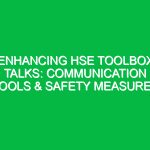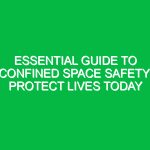Understanding Slip, Trip, and Fall Hazards
Slip, trip, and fall incidents are among the most common workplace accidents, accounting for a significant percentage of injuries across various industries. These incidents can lead to severe injuries, lost workdays, and increased healthcare costs. In the realm of Health, Safety, and Environment (HSE), understanding these hazards is crucial for creating a safe workplace.
The nature of slip, trip, and fall incidents is often rooted in environmental factors, human behavior, and equipment design. Slips occur when there is insufficient friction between a person’s footwear and the walking surface, often caused by wet or contaminated floors. Trips happen when a person encounters an obstacle, such as a loose cable or uneven flooring, while falls refer to the act of descending to a lower level, which can occur from various heights.
By prioritizing slip, trip, and fall prevention, organizations not only comply with safety regulations but also foster a culture of safety that benefits all employees.
Key Factors Contributing to Slip, Trip, and Fall Incidents
To effectively prevent slip, trip, and fall incidents, it’s essential to understand their contributing factors. Here are some of the most significant:
1. Environmental Conditions
Environmental hazards play a pivotal role in the likelihood of slips, trips, and falls. Wet or oily surfaces, loose mats or carpets, and uneven flooring can create serious risks. For instance, a manufacturing facility with a wet floor from a leaking pipe without proper signage can lead to multiple accidents. Regular maintenance and immediate attention to spills are vital in mitigating these risks.
2. Human Behavior
Human factors also contribute significantly. In a workplace where employees are rushed, distracted, or not wearing appropriate footwear, the risk of an accident increases. For example, an office worker hurrying to a meeting might not notice a loose wire on the floor, leading to a trip. Training programs focused on safe walking practices can help employees remain aware of their surroundings.
3. Equipment and Design
The design of workspaces and tools can either exacerbate or alleviate slip, trip, and fall risks. Poorly designed workstations, obstructed pathways, and inadequate lighting can significantly increase the likelihood of accidents. For instance, a poorly lit warehouse may hinder visibility, making it difficult to see obstacles. Regular audits of the workspace can help identify potential hazards that require attention.
Preventive Measures for Slip, Trip, and Fall Incidents
Implementing effective preventive measures is key to minimizing slip, trip, and fall incidents in the workplace. Here are some actionable strategies:
1. Conduct Regular Risk Assessments
Regularly assessing workplace conditions helps identify potential slip, trip, and fall hazards. This involves evaluating walking surfaces, checking for spills or debris, and ensuring that all areas are well-lit. Engaging employees in these assessments can provide valuable insights and foster a sense of ownership over workplace safety.
2. Maintain Clean and Dry Surfaces
Keeping walking surfaces clean and dry is essential. This includes promptly cleaning up spills, ensuring that carpets are secured, and maintaining outdoor areas free from ice and snow. Facilities should also implement a routine cleaning schedule, especially in high-traffic areas.
3. Improve Lighting
Good lighting is crucial in preventing slip, trip, and fall incidents. Ensure that all areas, especially staircases, hallways, and entrances, are well-lit. Installing motion-sensor lights in less frequented areas can also enhance visibility and safety.
4. Provide Proper Footwear
Encouraging or requiring employees to wear appropriate footwear can significantly reduce slip hazards. Shoes with slip-resistant soles can provide better traction and minimize the risk of slipping on wet surfaces. Organizations can consider providing footwear subsidies for employees who work in high-risk environments.
5. Use Warning Signs and Barriers
Visible warning signs and barriers are essential in alerting employees to potential hazards. For example, placing “Wet Floor” signs in areas where spills have occurred can remind employees to exercise caution. Barriers can also be effective in cordoning off areas where maintenance is being performed.
Training and Awareness Programs
Training plays a crucial role in slip, trip, and fall prevention. Employees should be educated about the risks and how to mitigate them. Here’s how to implement effective training programs:
1. Employee Orientation
During onboarding, new employees should receive training on workplace safety, focusing on slip, trip, and fall hazards. This orientation should include practical demonstrations of safe walking practices and how to report hazards.
2. Ongoing Safety Meetings
Regular safety meetings can reinforce the importance of slip, trip, and fall prevention. These meetings can include topics such as recent incidents, lessons learned, and discussions on improving workplace safety. Encouraging open dialogue can empower employees to share their experiences and suggestions.
3. Utilize Visual Aids
Using posters, videos, and interactive presentations can enhance the training experience. Visual aids can effectively communicate safety tips and highlight the importance of vigilance in preventing slip, trip, and fall incidents.
Real-Life Examples and Case Studies
Understanding real-world implications can enhance awareness and inform strategies. Here are a few case studies illustrating the impact of slip, trip, and fall prevention measures:
1. Manufacturing Facility Case Study
In a manufacturing facility, management observed a high number of slip and trip incidents. After conducting a thorough risk assessment, they found that spills were not being cleaned promptly, and floors were often cluttered with materials. By implementing a strict cleaning schedule, improving signage, and providing training, the facility saw a 50% reduction in incidents within six months.
2. Office Environment Case Study
An office building experienced multiple trips due to loose cables and poor lighting. By reorganizing workspace layouts, securing cables with cord covers, and enhancing lighting in common areas, the number of reported trip incidents dropped significantly. Employees reported feeling safer and more aware of their surroundings.
Regulations and Standards Related to Slip, Trip, and Fall Prevention
Various regulations govern slip, trip, and fall prevention in the workplace. Understanding these legal requirements can help organizations maintain compliance and promote safety:
1. Occupational Safety and Health Administration (OSHA)
OSHA provides guidelines and regulations designed to ensure workplace safety. Specific standards, such as 29 CFR 1910.22, address walking-working surfaces, outlining the responsibilities of employers to maintain safe environments. Compliance with these regulations is not only a legal obligation but also a moral one to protect employees.
2. National Safety Council (NSC)
The NSC offers resources and recommendations for organizations to enhance workplace safety. Their guidelines include best practices for slip, trip, and fall prevention, emphasizing the need for regular training and hazard assessments.
Conclusion
In conclusion, slip, trip, and fall prevention is a critical aspect of workplace safety within the HSE domain. By understanding the contributing factors and implementing effective preventive measures, organizations can significantly reduce the risk of these incidents. Regular training, risk assessments, and adherence to safety regulations are vital components of a successful safety program.
Promoting a culture of safety not only protects employees but also enhances overall productivity and morale. As we continue to navigate the complexities of workplace safety, it is crucial to remain vigilant and committed to preventing slip, trip, and fall incidents. By doing so, we create a safer and healthier work environment for all.


